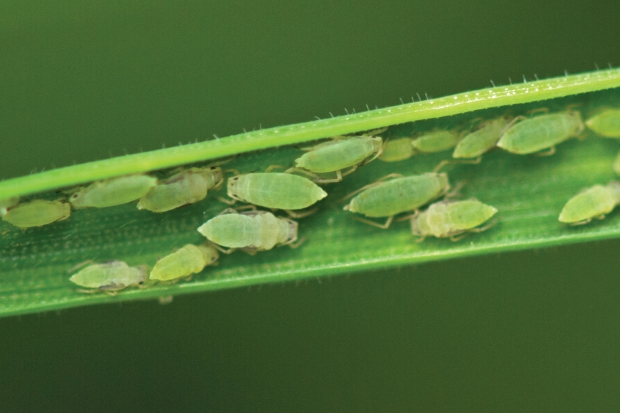Russian wheat aphid
Russian wheat aphid (Diuraphis noxia; RWA) was first identified in South Australia in 2016. This cereal pest is now present in cropping areas of SA, Victoria, Tasmania, New South Wales and Western Australia.

Research
We’ve achieved a growing knowledge base about RWA through our research investments. This is continually providing the Australian grains industry with a greater understanding of the pest and its potential impact, to inform management strategies.
In addition to experiments to determine aphid biotype (there is a single biotype in Australia), we’ve been investing in:
- research to determine the level of susceptibility or resistance of commercial wheat and barley cultivars to RWA
- RWA biology, ecology and economic thresholds under Australian conditions
- an investigation into alternate hosts for RWA
- trials looking at insecticide efficacy
- development of a green bridge risk forecasting tool
- assessing potential sources of plant resistance
- provision of practical resources for growers and advisers.
Important resources and knowledge generated from our research investments – including an action threshold calculator – are available via the provided links.
Migration and management
For most grain growing regions (Tasmania has been observed to be a frequent exception), RWA populations are expected to grow within cultivated crops over the winter. They will then disperse during a spring migration into refuges to ‘over-summer’, and then re-disperse back into emerging crops during an autumn migration.
Yield impact requires aphids to migrate into emerging crops at an early growth stage (during crop establishment) and to build to high numbers leading up to head emergence.
Together with the broader grains industry, we will continue to promote the FITE (find, identify, threshold approach and enact) strategy which was developed to provide growers and advisers with a simple guide to RWA management.
It involves:
- Find – look for aphids and the characteristic plant symptoms of infection including leaf streaking or leaf rolling on cereal crops and grasses
- Identify – positively identify RWA by consulting with an industry specialist
- Threshold approach – before deciding on your plan of attack consider thresholds for control, the presence of natural aphid enemies in the crop, crop growth stage and potential yield losses
- Enact – take appropriate action: manage your next steps including encouraging beneficial insects and protecting honeybees before implementing control options.
Resources

Important considerations when using action threshold advice for RWA.
Tools
Action threshold calculator
Videos
- RWA Green Bridge Surveillance
- RWA thresholds
- Russian Wheat Aphid: USA tips for Australia - F. Peairs | Grains Research Update 2017 | Bendigo
- GCTV20: Russian Wheat Aphid - Recommendations for ongoing management
- Russian Wheat Aphid: 'War Room' Briefing - Three Experts | 2017 Grains Research Update | Bendigo
- Integrated Pest Management to combat the Russian Wheat Aphid
- PestBites identification video by cesar
Podcasts
Publications
Websites
- Russian wheat aphid thresholds and green bridge risk project information page
- Russian wheat aphid PestNote
- Refer to the Australian Pesticides and Veterinary Medicines Authority products and permits databases for chemical control options available for RWA in grain crops
